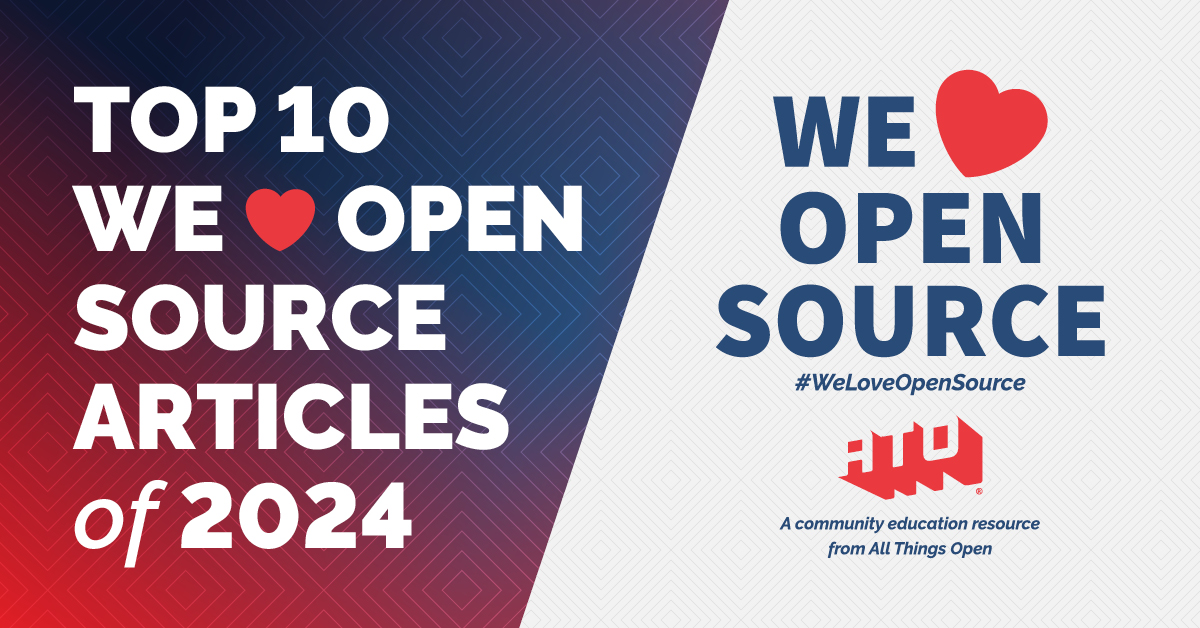We  Open Source
Open Source
A community education resource
Top 10 We Love Open Source articles of 2024
Our most popular AI, open source, and technology guides, tutorials, and stories of the year.

Ready to take your tech skills to the next level? Our top 10 articles of 2024 cover a diverse range of topics, from AI and machine learning to system administration and programming. Whether you’re a seasoned developer or a curious newcomer, we’re confident you’ll find something of interest. Join us as we explore the latest trends and best practices.
Why are my ZFS disks so noisy?
Is your ZFS file system sounding like a jet engine? This article explores the causes of excessive noise in ZFS drives, including fan issues and pool resilver operations. It also provides troubleshooting tips to help you identify the source of the noise and quiet down your ZFS storage. Read the article. (Also featured on HackerNews.)
How to import data to your database with DBeaver
This guide offers a helpful guide for importing data into a database using DBeaver. It walks you through the process of importing data from a file without writing any code, creating new database tables, and even importing data from multiple files at once. Finally, you’ll learn how to customize each column by adjusting its name, data type, or length. Read the guide.
Comparing GitHub Copilot and Codeium
GitHub Copilot and Codeium are two of the leading AI-powered code completion tools. This article compares the strengths and weaknesses of both, providing insights on how each tool can boost your development efficiency. While both tools provide similar functionality and features, they each have their distinct advantages and limitations. Read the guide.
Build a local AI co-pilot using IBM Granite Code, Ollama, and Continue
If you’re looking to build a local AI-powered co-pilot without relying on cloud services, this tutorial is for you. By using open source components like IBM Granite Code, Ollama, and Continue, you can set up a self-contained AI co-pilot on your own workstation. This solution helps address data privacy, licensing, and cost concerns, all while maintaining a high level of functionality. Read the tutorial.
Technology history: Where Unix came from
This article traces the origins of Unix, from its roots in the Multics project at MIT to its development at Bell Labs. It highlights key figures like Ken Thompson and Dennis Ritchie, and discusses the design principles that shaped Unix’s influence on modern operating systems. Read the article.
Another open source DOS
This article explores the world of open source alternatives to popular DOS programs, providing users with a free and customizable software ecosystem. It explores various open source options for tasks like file management, image manipulation, and even gaming, empowering users to explore alternatives to traditional DOS software. Read the article.
12 ways to incorporate AI into CI/CD processes
This tutorial explores how AI can be leveraged in CI/CD pipelines to streamline development processes. It details how AI can automate tasks, simplify routine development work, and optimize resource allocation. Examples include AI-powered test case generation, test selection optimization, pipeline analysis, and even on-the-fly code fixes. Read the tutorial.
Learning to program: 2 ways to copy files in C
This tutorial is a practical guide for C programming beginners. It breaks down the process of copying files in C, starting with a straightforward loop-based approach and progressing to a more efficient memory buffer method. Whether you’re new to programming or looking to solidify your C skills, this article offers valuable insights and clear code examples. Read the tutorial.
5 Linux backup solutions to explore
This article explores 5 different solutions for backing up data on Linux. Whether you need a simple, reliable tool like the tar command or a more feature-rich option like Deja Dup, there’s a solution here to fit your needs. For a more comprehensive solution, consider tools like Restic or Timeshift. Read the article.
Getting started with Llamafile tutorial
This tutorial dives into Llamafile, a Large Language Model (LLM), explaining what it is and how it works. It also explores privacy concerns surrounding LLMs and provides a helpful guide on how to use Llamafile, including examples. Read the tutorial.
The opinions expressed on this website are those of each author, not of the author's employer or All Things Open/We Love Open Source.
